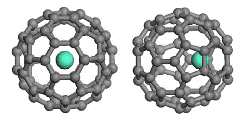Department of Chemistry
Ab initio calculation of carbon clusters. II. Relative stabilities of fullerene and nonfullerene C24
Date of this Version
2-25-2008
Abstract
Chemical stabilities of six low-energy isomers of C24 derived from global-minimum search are investigated. The six isomers include one classical fullerene (isomer 1) whose cage is composed of only five- and six-membered rings (5/6-MRs), three nonclassical fullerene structures whose cages contain at least one four-membered ring (4-MR), one plate, and one monocyclic ring. Chemical and electronic properties of the six C24 isomers are calculated based on a density-functional theory method (hybrid PBE|PBE functional and cc-pVTZ basis set). The properties include the nucleus-independent chemical shifts (NICS), singlet-triplet splitting, electron affinity, ionization potential, and gap between the highest occupied molecular orbital and the lowest unoccupied molecular orbital (HOMO-LUMO) gap. The calculation suggests that the neutral isomer 2, a nonclassical fullerene with two 4-MRs, may be more chemically stable than the classical fullerene (isomer 1). Analyses of molecular orbital NICS show that the incorporations of 4-MRs into the cage considerably reduce paratropic contributions from HOMO, HOMO-1, and HOMO-2, which are mainly responsible for the sign change in NICS from positive for isomer 1 (42) to negative (−19) for isomer 2, although C24 clusters satisfy neither 4N+2 nor 2(N+1)2 aromaticity rule. Anion photoelectron spectra of four cage isomers, one plate, one monocyclic ring, and one tadpole isomer, as well as three bicyclic ring isomers are calculated. The simulated photoelectron spectra of monoand bicyclic rings (with C1 symmetry) appear to match the measured HOMO-LUMO gap (between the first and second band in the experimental spectra) [S. Yang et al., Chem. Phys. Lett. 144, 431 (1988)]. Nevertheless, the nonclassical fullerene isomers 3 and 4 apparently also match the measured vertical detachment energy (2.90 eV) reasonably well. These results suggest possible coexistence of nonclassical fullerene isomers with the mono- and bicyclic ring isomers of C-24 under the experimental conditions.


Comments
Published in THE JOURNAL OF CHEMICAL PHYSICS 128, 084301 (2008). Copyright © 2008 American Institute of Physics. Used by permission.